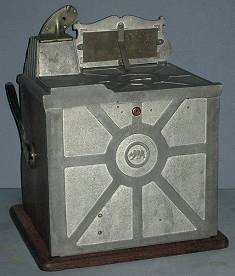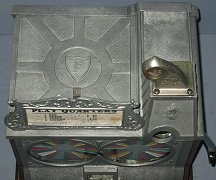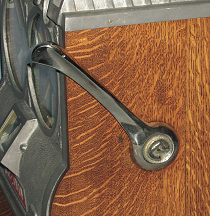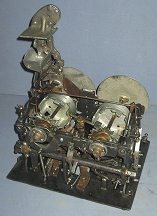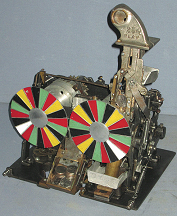The Fey Duo
By Johhny Duckworth
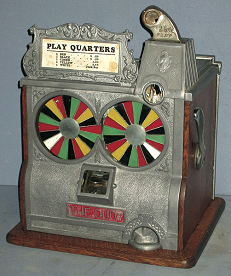 Charles Fey produced many different coin operated machines, which are all highly sought after and cherished by collectors today. Almost everyone in this hobby views a Fey machine as something special. It is no doubt that this feeling comes with the recognition that he invented the Fey Liberty Bell, which is known as the first three reel slot machine ever produced. Although he would revamp others, this would be the only three reel slot that Fey would entirely make on his own. He went on to produce and revamp many other coin operated devices. Some of his best known gambling machines are The Liberty Bell, On the Level, On the Square, The Duo, Little Chief, Silver Cup, Rockaway, Midget, 3 Jacks, The Ace, along with numerous others.
Charles Fey produced many different coin operated machines, which are all highly sought after and cherished by collectors today. Almost everyone in this hobby views a Fey machine as something special. It is no doubt that this feeling comes with the recognition that he invented the Fey Liberty Bell, which is known as the first three reel slot machine ever produced. Although he would revamp others, this would be the only three reel slot that Fey would entirely make on his own. He went on to produce and revamp many other coin operated devices. Some of his best known gambling machines are The Liberty Bell, On the Level, On the Square, The Duo, Little Chief, Silver Cup, Rockaway, Midget, 3 Jacks, The Ace, along with numerous others.
The Fey Duo is a unique two wheel color match payout machine. It may resemble some of the earlier two wheel color match slots like The Silver Cup, Loving Cup, The Twin, or the Bungalow. However, it does have one improvement they don't have……..a jackpot. The Duo was produced in the 1920's when the addition of a jackpot to a slot machine had just exploded as the new big improvement. This machine was also made out of aluminum and wood, to cut down on the weight of the earlier cast iron models. It has an aluminum front, top casting, and back door. The wooden bottom and sides are made of oak. The back door has a bear cast into the center, and you will find this identical bear on the California state flag. Fey no doubt used this symbol to signify that he was in California, as well as using that signage on other machines such as the On The Level for example.
The Duo mechanism doesn't resemble the other two wheel color match machines as it has a gooseneck coin entry. The mechanism has cast aluminum cups with notches on the back that are placed on each wheel shaft and a center T-bar between them to detect payouts. The other two wheel machines will typically have thin hollow cylinders on each wheel shaft with holes everywhere to identify payouts. The Duo mechanism started out with only five colors on the wheel but Fey eventually added a blue color to make six different payouts, possibly to keep up with the bell machines at that time.
The earliest known Duos have surfaced with an interesting front casting. They don't have Fey's initials or the Indian cast on either side of the jackpot but they still retain Fey's initials on the handle and the top casting. Serial #12 and #25 represent such examples. I can only imagine a disheartened Charles Fey standing in his workshop assembling the first batch of Duo's only to discover that once the top sign was in place, it would ultimately hide the top casting decorated with a large badge containing the letter “F” representing his name and hard work. The handle contained his initials in the center but since it can only be seen from the side of the machine he wouldn't get much recognition. He obviously dressed up the next batch starting with serial #26 and added his initials and the Indian to the front. He first used the Indian symbol in 1909 on The Little Chief. When talking with Marshall Fey about his grandfather using the two images of the bear and Indian, he thought it was possibly because California's biggest sports teams at that time were the California Bears and the Stanford Indians.
The highest number known on a Fey Liberty Bell is #99 and since so few of them are known today it proves that Fey didn't have an enormous production facility like his competition. I tried to track down as many Duo serial numbers as possible but sadly, they also did not survive in great numbers. Some of the serial numbers known on the Duos that I have been able to locate are 12, 25, 26, 34, 41, 47, 48, 50, 88,105, & 388. I have also found a few of them with possible operator numbers stamped on the goosenecks such as 660, 6073 and others with no numbers at all. They were produced in three different denominations, penny, nickel, and quarter. The serial numbers above represent two penny machines, four nickel machines, and seven quarter machines.
If you have any information that you would like to share on the Duo please contact me at Johnny@kccoinop.com or you can visit my website where I have three different Duos pictured www.kccoinop.com. I want to thank Marshall Fey and all of the collectors who took the time to share their serial number as it really helps to tell the story on some of these rare coin operated machines. No one knew why the Duo had two different front castings, but the serial numbers helped solve that mystery. Thanks again.
